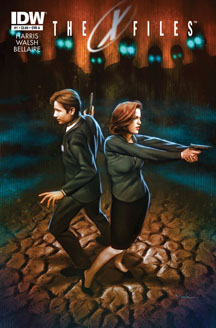IDW’s “X-Files” Season 10 comics mark the first time Chris Carter has a story credit on an “X-Files” comic – he co-wrote Issues 1-5, “Believers,” with series helmer Joe Harris – but, ironically, IDW’s series now seems less canonical than Topps’ or Wildstorm’s. Although neither Carter nor Harris has issued a statement about the canonicity of the series, it seems pretty obvious that this is what happened: When IDW’s “X-Files” launched in 2013, it was intended to be canonical. Then, in 2016, Carter changed his mind when he relaunched “The X-Files” for TV, no doubt figuring that too much of the TV audience was unfamiliar with the comic to make the new episodes tie in with the comic.
The final issue of Season 11 will be released later this month, and I suppose it could theoretically rectify the contradictions between the comic and TV event series, although Harris has his work cut out to pull that off. Then IDW will launch a new ongoing title that supposedly will fit with the new TV continuity. The irony of all this is that the comic – along with Kumail Nanjiani’s “X-Files Files” podcast and a general public thirst for more “X-Files” – is part of what led to the new episodes. I’m not complaining, but it is kind of frustrating that Seasons 10 and 11 have been rendered non-canon, because the first thing I notice on my reread of Season 10 Issues 1-9 (2013-14) is that they are really good.
The most blatant continuity glitch is the time at which Mulder and Scully return to the FBI’s X-Files division, as well as their relationship status when they do so. In the comic, they return to the X-Files in 2013, and in the TV show, they return to the X-Files in 2016; both stories feature elements that set the stories in real time. In the comic, M&S are a couple, still living together in their rural Virginia house from “I Want to Believe.” In the TV show, they have split up, although they still care deeply about each other and work well together.
An additional possible continuity glitch is that Season 10, Issue 2 reveals that the Lone Gunmen faked their deaths – as portrayed in Season 9’s “Jump the Shark” – with the help of the federal government. In “Babylon,” the fifth episode of the six-episode event series – which, to confuse matters further, is now referred to as “Season 10” by many sources, including IMDB – Mulder hallucinates playing cards with the Lone Gunmen. While the suggestion is that he is seeing dead people, the sequence doesn’t definitively say the Gunmen are dead. It gets weirder: In an Entertainment Weekly interview, Carter said “I didn’t want to pretend they weren’t dead but was looking for any way to bring them back.” This is despite the fact that he co-wrote the comic story that revealed they faked their deaths!

So, in a nutshell: Carter changed his mind. The IDW comics were originally canonical, and now it seems they aren’t. Basically, “X-Files” fans are in the same position as “Star Wars” fans; there are now two continuities: The one that used to be canonical, and the one that is currently canonical.
At any rate, whether canonical or not, these stories are worth a second look, so here goes:
Wildstorm’s run ended in 2011 and IDW’s started in 2013, meaning that 2012 is the only year between 2008 and today that featured no new “X-Files” stories. This is supremely ironic considering that Season 9 ended with the prophecy that alien colonization would begin on Dec. 22, 2012, the last day of the Mayan calendar. The TV event series vaguely told us that colonization did indeed “begin” in 2012, but not in a way that the populace noticed. In Season 10 Issue 3, Mulder tells the Cigarette-Smoking Man (later revealed to be an Acolyte alien shapeshifter who passes himself off as the CSM thanks to information gleaned from the Acolytes’ hacking of the X-Files), “You told me when the aliens were going to invade and none of it came to pass!”
In addition to addressing the 2012 question, “Believers” immediately addresses the two major oversights from “I Want to Believe”: The lack of continuation of the narrative about William, and the lack of mention of Doggett and Reyes. In “Believers,” much like in the TV event series, Scully is haunted by wondering what happened to the son she put up for adoption. The arc also reveals that Doggett and Reyes still work for the FBI, albeit not as partners and not in the X-Files division, which has been closed since 2002. Doggett investigates a pipeline of magnetite, which the Syndicate (or its post-Syndicate equivalent) constructed in a circle around Yellowstone Park as a barrier to contain the Acolytes. Reyes checks in on William’s adoptive parents in Wyoming and finds they have been murdered by the Acolytes. (Reyes’ continued FBI employment isn’t necessarily a contradiction with the TV event series, as we don’t know the precise timeframe she was nursing the CSM back to health, having been blackmailed by him.)
In other nods to the second movie, the restless Mulder is writing (with a typewriter!) “I Want to Believe: A Memoir by Fox Mulder”; in the film, Scully suggested he write a book about his X-Files experiences as a balm for his restlessness. Also, Scully is still working at (presumably) the same children’s hospital. For some reason, she and Mulder have changed their last name to “Blake,” which was not the case in the film. It’s not much of a protection from the Acolytes, at any rate.
One thread IDW does not continue from “I Want to Believe” is the question of whether Scully’s cancer patient, Christian, survived his cutting-edge stem-cell treatment, or whether he died. That remains a mystery in both the comics and the TV series, which is odd because he should occupy an important place in Scully’s heart along with William and Emily, her other lost children.
“Believers” plays very much like a sweeps-month mythology story, featuring the seeming hanging death of Skinner, the seeming return of the CSM, the seeming shooting of Mulder at the hands of Scully (and vice-versa!), M&S’s near-reunion with their son, and the disappearances of Doggett and Reyes. It has a bit of a “greatest hits” feel. In Season 2’s “Colony,” Scully had to figure out which Mulder was real and which was the shapeshifter, and the Mulder-bodysnatching idea came up yet again in Season 4’s “Small Potatoes” and Season 6’s “Dreamland.” And the CSM has, of course, returned from the dead many times.
It’s somewhat surprising that “Believers” is such a blatant continuation of the mythology, putting to rest the notion that Season 9 put a bow on the mythology in any way, shape or form. Harris is saying that if “The X-Files” is going to continue, it should aggressively continue – and on this re-read, I’m in agreement. The TV event series also aggressively threw us back into mythology mode with its first episode.
In the subsequent issues, Harris goes solo, without the assistance of Carter, but these next four issues are even better. “Being for the Benefit of Mr. X” (Issue 8), like “Believers,” features art by Michael Walsh, who has a sketchy style I don’t like as much as the crisp, clear renderings from Topps, Wildstorm and other IDW artists. Still, I got used to it, and the B&W flashback scenes in Issue 8 are wonderfully moody, especially when the gun-toting schoolkids are rendered in red.
“Being for the Benefit of Mr. X” flashes back to 1987, when Mr. X covered up a school shooting that came about from a mind-control experiment botched by the Syndicate related to Purity Control (the Syndicate’s plan to create alien-human hybrids). The current “Mr. X” is – like the phony CSM – an Acolyte shapeshifter armed with knowledge from the X-Files hack, which is kind of a hoary premise, but the flashback is wonderful, as it shows Mr. X interacting with the CSM and Deep Throat back in the day. Indeed, Deep Throat gives himself the unofficial code-name in this story after he and Mr. X have a showdown in front of the Washington Post building (where Watergate’s Deep Throat made contact with reporters in the 1970s).
The fact that IDW delves so heavily into the mythology is the biggest difference from the Topps and Wildstorm comics. But the publisher doesn’t abandon Monster of the Month yarns, and indeed, “Hosts” (Issues 6-7) struck me as the best “X-Files” comic story ever on my original read. While I was no doubt enamored simply by the concept of revisiting the famous half-human, half-flukeworm sewer monster from Season 2’s “The Host,” the sequel is certainly no hack job. As new Deputy Director Morales asks M&S to button up old cases, we learn the complete backstory of the Flukeman, which dates back to the Chernobyl incident. But more importantly, Harris – with artists Elena Casagrande and Silvia Califano delivering crisp yet moody art more to my liking – comes up with delicious creep-outs. Scully unfreezes the half-Flukeman from the original case, and it begins to regenerate its upper half! During the show’s original run, around Season 7 or so, Carter said he’d like to do more MOTW sequels once the mythology was wrapped up. That never happened in earnest; if it had, “Hosts” is the type of episode I would’ve liked to have seen.
“Chitter” (Issue 9) is not a sequel, but it certainly calls to mind Season 3’s “War of the Coprophages” in being cockroach-centric. It ends with a creepy reveal of a basement full of skeletonized missing persons in a small Pennsylvania town, and it shows that Harris can effectively cram a standalone yarn into one issue, like Topps used to do. He makes no overt connection to the “Coprophages” cockroaches (which were actually government-created spy devices), but it’s interesting to note that these cockroaches do control the minds of people who are “in despair and pain,” and that Scully feels light-headed around their influence. Scully’s depression and malaise over giving up William for adoption were also played up in “I Want to Believe” and the TV event series.
Whether the TV event series or IDW did the post-“I Want to Believe” story “better” is open to debate (I like both of them). It’s undeniable, though, that IDW got there first, and Harris does an admirable job launching Season 10. But can he keep it up? More on that in future flashback posts.

